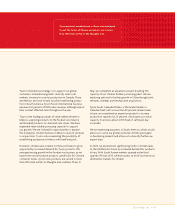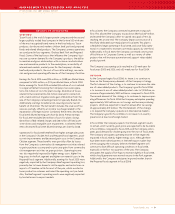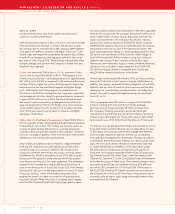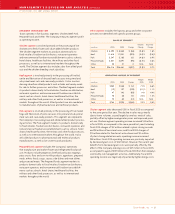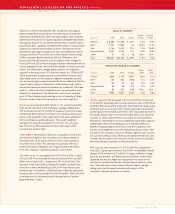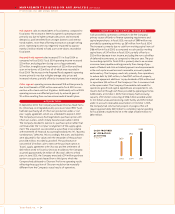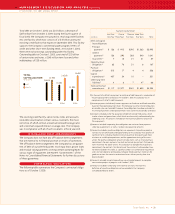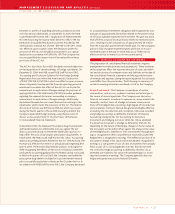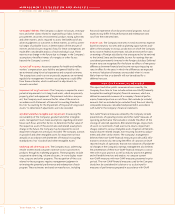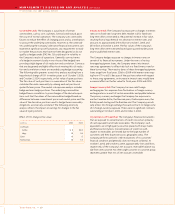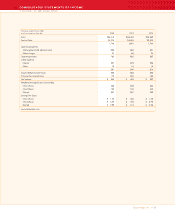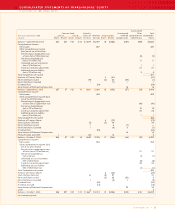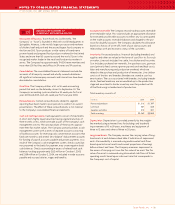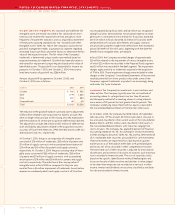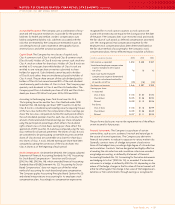Tyson Foods 2005 Annual Report Download - page 29
Download and view the complete annual report
Please find page 29 of the 2005 Tyson Foods annual report below. You can navigate through the pages in the report by either clicking on the pages listed below, or by using the keyword search tool below to find specific information within the annual report.
>> MANAGEMENT’S DISCUSSION AND ANALYSIS (CONTINUED)
TYSON FOODS, INC. 2005 ANNUAL REPORT
>>>>>>>>>>>>>>>>
>>>>>>>>>>>>>>>>
Tyson Foods, Inc. >> 27
between 3% and 9% of qualifying domestic production income
over that period. Additionally, on December 21, 2004, the FASB
issued FASB Staff Position 109-1, “Application of FASB Statement
No. 109, Accounting for Income Taxes (SFAS No. 109), to the Tax
Deduction on Qualified Production Activities Provided by the
American Jobs Creation Act of 2004” (FSP 109-1). FSP 109-1, which
was effective upon issuance, states the deduction under this
provision of the AJC Act should be accounted for as a special
deduction in accordance with SFAS No. 109. The Company has
not yet quantified the impact that will be realized from these
provisions of the AJC Act.
The AJC Act also allows for an 85% dividends received deduction
on the repatriation of certain earnings of foreign subsidiaries. On
December 21, 2004, the FASB issued FASB Staff Position 109-2,
“Accounting and Disclosure Guidance for the Foreign Earnings
Repatriation Provision within the American Jobs Creation Act
of 2004” (FSP 109-2). FSP 109-2, which was effective upon issuance,
allows companies time beyond the financial reporting period of
enactment to evaluate the effect of the AJC Act on its plan for
reinvestment or repatriation of foreign earnings for purposes of
applying SFAS No. 109. Additionally, FSP 109-2 provides guidance
regarding the required disclosures surrounding a company’s
reinvestment or repatriation of foreign earnings. Additionally,
the Internal Revenue Service issued three notices relating to the
repatriation, which clarify the provisions of the Act. The latest in
the series of notices was IRS Notice 2005-64, which was issued
during the fourth quarter of fiscal 2005. During fiscal 2005, the
Company repatriated foreign earnings using the provision of
the act as discussed in Note 17, “Income Taxes” of the Notes
to Consolidated Financial Statements.
In December 2003, the Medicare Prescription Drug, Improvement
and Modernization Act of 2003 (the Act) was signed. The Act
allows a possible subsidy to retirement health plan sponsors to
help offset the costs of participant prescription drug benefits. In
March 2004, the FASB issued Staff Position No. 106-2, “Accounting
and Disclosure Requirements Related to the Act” (the Position). The
Position was effective for interim or annual periods beginning after
June 15, 2004. The Position allowed plan sponsors to recognize or
defer recognizing the effects of the Act in its financial statements
until specific accounting guidance for this federal subsidy was issued.
In the fourth quarter of fiscal 2005, the Company concluded the
prescription drug benefits included in its postretirement medical
plan is actuarially equivalent to Medicare Part D under the Act. In
accordance with FASB Staff Position 106-2, the Company decreased
its accumulated postretirement obligation and recognized an actu-
arial gain of approximately $55 million related to the present value
of all future subsidies expected to be received. This gain was more
than offset by actuarial losses primarily related to increased claims
costs, resulting in a net actuarial loss of approximately $9 million
from the Company’s postretirement health plan. It is the Company’s
policy to fully recognize experience gains and losses of its post-
retirement plans in the year in which they occur. There was no
effect on service or interest cost in the current period.
CRITICAL ACCOUNTING ESTIMATES
The preparation of consolidated financial statements requires
management to make estimates and assumptions. These estimates
and assumptions affect the reported amounts of assets and liabili-
ties and disclosure of contingent assets and liabilities at the date of
the consolidated financial statements and the reported amounts
of revenues and expenses during the reporting period. Actual results
could differ from those estimates. The following is a summary of
certain accounting estimates considered critical by the Company.
Financial instruments: The Company is a purchaser of certain
commodities, such as corn, soybeans, livestock and natural gas in
the course of normal operations. The Company uses derivative
financial instruments to reduce its exposure to various market risks.
Generally, contract terms of a hedge instrument closely mirror
those of the hedged item, providing a high degree of risk reduction
and correlation. Contracts that are designated and highly effective
at meeting the risk reduction and correlation criteria are recorded
using hedge accounting, as defined by Statement of Financial
Accounting Standards No. 133, “Accounting for Derivative
Instruments and Hedging Activities” (SFAS No. 133), as amended.
If a derivative instrument is a hedge, as defined by SFAS No. 133,
depending on the nature of the hedge, changes in the fair value of
the instrument will be either offset against the change in fair value
of the hedged assets, liabilities or firm commitments through earn-
ings or recognized in other comprehensive income (loss) until the
hedged item is recognized in earnings. The ineffective portion of an
instrument’s change in fair value will be immediately recognized in
earnings as a component of cost of sales. Instruments the Company
holds as part of its risk management activities that do not meet
the criteria for hedge accounting, as defined by SFAS No. 133, as
amended, are marked to fair value with unrealized gains or losses
reported currently in earnings. The Company generally does not
hedge anticipated transactions beyond 12 months.


